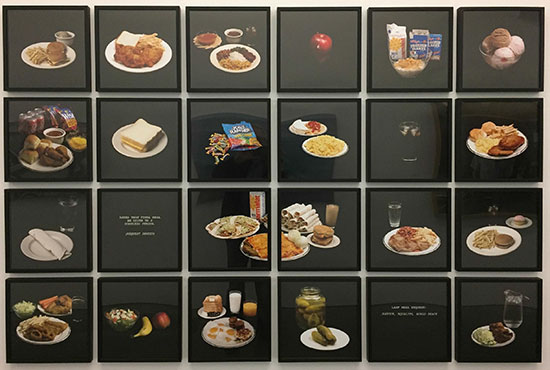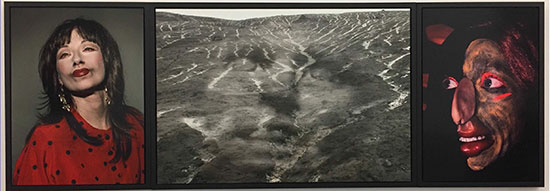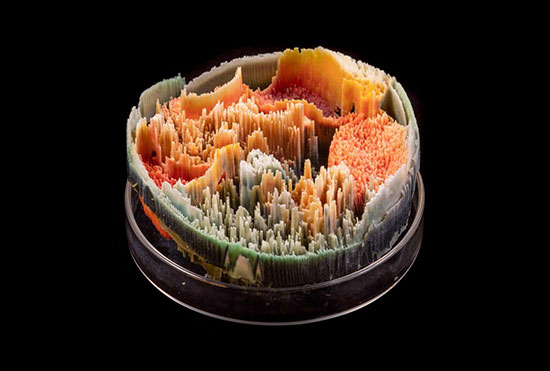It takes about three seconds to know if one should spend five minutes. This conclusion applies to anyone listening to the wide variety of vocal stylings presented randomly on “America’s Got Talent” or “Britain’s Got Talent” or a dozen other talent shows where hopefuls grasp the mike facing a wall of unsympathetic neighbors.
That just about anyone can recognize what has aesthetic value in vocal ability doesn’t translate easily to visual art, wherein a large measure of the value lies in traditions and historical sequences—a mostly learned application of talent rather than one that seems innate. This is not to say that for a professional artist any assessment of visual material is any less clear or quick. No, it is nearly similar: any working artist with a developed eye can stroll through the aisles of a cluttered art fair and discern the peerless from the tchotchke in a glance.
That’s why it is especially interesting when an exhibition is comprised of visual art selected by other professional artists. Such is the smart format on view currently, and for the third time, at the Parrish Art Museum in Water Mill, N.Y. The museum’s sizeable show, “Artists Choose Artists,” features the work of seven artist-selectors and 14 selected artists.
The third iteration of this show draws on artists of the East End of Long Island. Generally I shy from zip code shows as it’s a crummy way to gestalt art, but there is no evidence here of the typical unevenness observed in many such installations, probably because of the vast and varied artist community on the East End.
Each of the seven artist-jurors—Tina Barney, Lynda Benglis, Donald Lipski, Tony Oursler, Jorge Pardo, Cindy Sherman, Leo Villareal—selected two artists from some 200 online submissions for this show, and then followed up with studio visits to confirm their instincts. Each selector also exhibits some of his or her own work alongside the artists they selected, creating some fascinating relationships. Birds of a feather ...
I’ll start with a home run from artist Jackie Black (selected by Tony Oursler) whose photography is a show unto itself. Black obtained a list of “last meal” requests from those executed in American prisons and then purchased and photographed the food requested as a classical still life. It is a sad and jarring installation that invites an anthropological reflection on the races and social classes of lives that end strapped to a gurney. Mostly they look like calorie-loaded Denny’s meals, handfuls of French fries, hills of mashed potatoes, greying burgers, store-bought fried chicken, and white bread, lots of white bread—what’s with the white bread?
The outlier is a carrot salad with a banana and apple on the side. Was this the choice of a healthy person who had performed the unthinkable, or a clever signaling of virtue by a doomed sociopath?
.

"Last Meal" by Jackie Black, 2001-03.
.
Mostly it is the comfort food of those not blessed; there is no chateaubriand or eggs étouffée. Instead the plates contain the quick sugar and fats of the short view, of the unmoneyed, each one the last nourishment before state sanctioned homicide.
There is a surprising amount of material about last meals circulating, as it is a swivel-head subject at which one can’t help but stare: Adolf Eichmann quaffed a bottle of Israeli wine before his hanging, Saddam Hussein refused his dish, and Irish rebel Roger Casement would taste only the Communion wafer.
Cindy Sherman is fresh from a major survey of her work held on the left coast at the Broad Museum in downtown Los Angeles. In this show she exhibits one of her own works next to those of the artists she selected, Bill Komoski and Toni Ross.
Here we see a departure from the clever selfies that earned Sherman a lead role in the Pictures Generation but that cannot define her work as there are too many outliers, especially her monster images. Along this line Sherman exhibits a dark spirit triptych as wrenching as anything Francis Bacon painted, and that’s saying something.
.

"Untitled" by Cindy Sherman, 2015.
.
On the left we see one of her society-women portraits and on the right a leering monster typical of her work in the early 1990s that puzzled her public. In the center is a barren landscape, or perhaps a lava field with the shadow of herself superimposed on the topography. The effect of a triptych is greater than the sum of its parts. This is the reason this form appears so often in contemporary art, and a stellar example is to be seen here.
.

"2-14-15" by Bill Komoski.
.
One of Sherman’s two artist selections, Bill Komoski, exhibits nearby with a mature painting: a solid piece of abstraction with climbing paint filled pockets that turn his flat surface into more of a 3D sculpture. I would rate it the standout painting of this exhibit. Clever form not seen before; colors that date from an earlier time, perhaps seen in Brueghel; and the downward dripping of an ascending figure all show there is still plenty of juice to be had in non-objective art. The Parrish would be remiss not to hang onto this piece.
.
.
Artist-juror Leo Villareal fills a wall with a bright array of LED pin lights programmed to throw shapes among the array. Lots of museum goers were staring at this noisy object, but after a moment I puzzled over the lack of content. Similar technology in billboard-size image generators appears nearly everywhere now, in Times Square for 20 years and in the Ginza district of Tokyo for even longer, but those LED fields feature information and are filled with images.
Villareal’s work is closer to the early pixelated cathode TV tubes that entered our living rooms in the 1940s along with the Heathkit pattern generators that Eisenhower-era Boy Scouts built for their electronics merit badge. Or the silly tennis shoes with LED strips embedded in their soles on sale at K-Mart. He seems to be suggesting that the stone-in-a-pond ripples are sufficient for the expensive media he has constructed. Though I would disagree, I see potential and will watch to see if he finds art in this decoration.
Suzanne Anker, selected by Donald Lipski, exhibits curious simulations of petri dish cultures created with 3D printing, producing wonderful handheld universes of life beginning at bacteria. The colorful and ultra fine features of these sculptures finally utilize the abilities of these new “printers”; heretofore sculptures from this recent technology appeared similar to lumpy vacuum-formed pop cartoons.
Anker’s layered magic is consistent with her life’s work of documenting the intersection of biological processes and visual art. Something not so improbable as it might sound, as the forms generated by effervescent DNA eclipse the imaginations of trained artists, especially those working abstractly. It is an immensely rich area and one in which she specializes.
.

"Remote Sensing (04)" by Suzanne Anker, 2013.
.
All in all the Parrish has a strong show worth going out of one’s way to see. There is much here for the eye and the soul.
“Artists Choose Artists” artist-jurors and their selections:
Tony Oursler with Jackie Black and Marianne Weil
Tina Barney with Dinah Maxwell Smith and RJT Haynes
Lynda Benglis with Garrett Chingery and Saskia Friedrich
Jorge Pardo with Anne Bae and Monica Banks
Cindy Sherman with Bill Komoski and Toni Ross
Leo Villareal with Karin Waisman and Almond Zigmund
Donald Lipski with Suzanne Anker and Ben Butler
_____________________________
BASIC FACTS: “Artists Choose Artists” is on view October 30, 2016 to January 16, 2017 at the Parrish Art Museum, 279 Montauk Highway, Water Mill, NY 11976. www.parrishart.org
_____________________________
Copyright 2016 Hamptons Art Hub LLC. All rights reserved.
